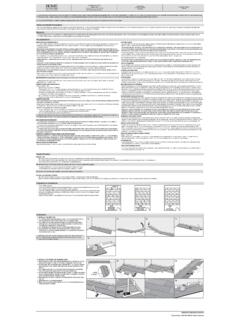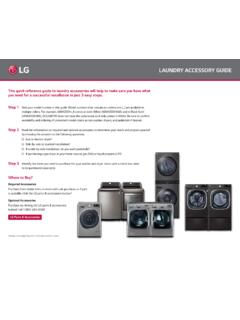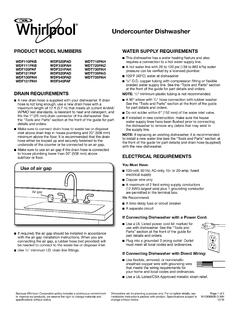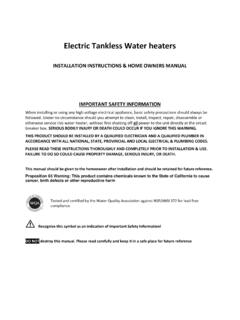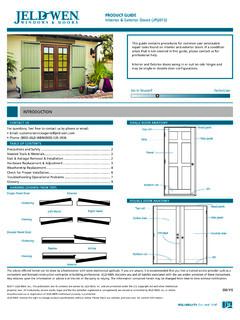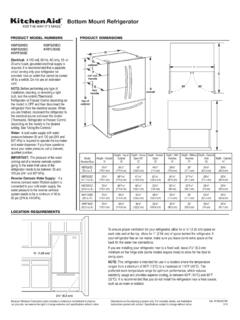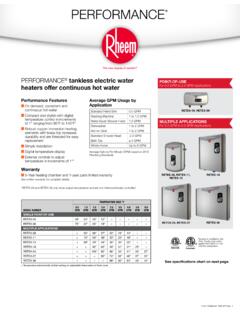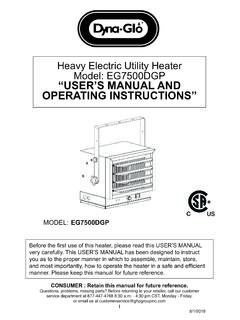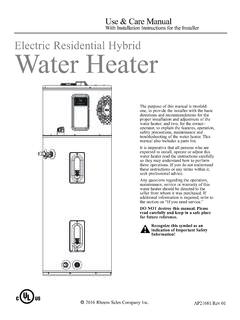Transcription of Retrof itting Existing Sidewalls r e ib f nee Ghwir t ...
1 Retrof itting Existing Sidewalls with Greenf iber Insulation Contractor Work InstructionsUS Greenf iber, LLC 5500 77 Center Drive, Suite 200 Charlotte, NC 28217 800-228-0024 Existing Sidewalls with Greenf iber Insulation Contractor Work InstructionsMany homes built prior to 1970 have no insulation in the wall cavities. SANCTYARY by Greenf iber is engineered to fill the tiny joints, crevices and gaps hidden within walls. Highly effective as sound insulation, it serves as a scientifically advanced barrier capable of muffling sounds that typically infiltrate and reverberate through our homes. Proven to reduce the power of sound by up to 60% following instructions are for contractors for the purpose of retrofitting Existing Sidewalls with Greenf iber Insulation.
2 These instructions are designed for use with Greenf iber s SANCTUARY and INS765LD products for installation in sidewall cavities. Follow the sidewall coverage charts on the bags to assure that the proper amount of insulation is : Free: 800-228-0024 Fax: 704-522-3748US Greenfiber, LLC 5500 77 Center Drive, Suite 100 Charlotte, NC Installation Retrofitting any part of a home s envelope will cause changes in air, heat and moisture flow. Contractors must understand how this installation will impact the house, , ventilation and combustion air requirements. Examine both the inside and outside of a home to determine areas that are inappropriate for installation.
3 For example: Do not insulate any home that has active knob and tube wiring. Where moisture related problems are evident, the source of the problems must be determined and corrected before proceeding. Do not install insulation in stud runs where heat-producing devices such as an unprotected chimney, a fireplace, etc. might cause severe overheating. Building assembly details such as balloon framing, fire blocking, pocket door connections, drywall gaps or other leak points must be taken into consideration when blowing Greenfiber Insulation into a house. Greenf iber s Material Data Safety Sheet (MSDS) recommends the use of eye and respiratory protection if necessary when installing this product.
4 The insulation contractor is responsible for managing housekeeping and engineering controls below nuisance dust levels. Follow all OSHA guidelines for safety requirements including 29 CFR Duty to Have Fall Protection. Various other local, state and federal rules and guidelines may through the interior wall is very difficult and is not detailed here. While it can be done, there is a wide range of other considerations related to someone currently occupying the home that present challenges to interior wall Equipment: Insulation blowing machine capable of at least psi at the end of the hose Not all insulation blowing machines meet this requirement; please check with Greenf iber Customer Service for verification.
5 -inch fiberglass rod Hose clamps Utility knife Filter (such as sponge) Wood, plastic, cork or Styrofoam plugs Drill and a 2 to 3-inch hole saw / Forstner bit 50-100 ft. of 3-6 inch inside diameter ribbed hose 1 to 1 -inch reducer nozzle 12 ft., 1 1/8 to 1 -inch inside diameter tube Best practice: 1 1/8 to 1 - inch tube will match sturdiness of a thin wall irrigation hose Note: When connecting hoses, a gradual reduction from the outlet to the 1 1/8 - 1 inch hose will yield the best Tube Fill MethodThe one-hole tube fill method is recommended by state Weatherization Assistance Programs for the retrofit of Sidewalls , and is the Greenf iber preferred method for retrofitting Existing Sidewalls .
6 When performing Weatherization Assistance Program work, follow the instructions CheckGreenf iber recommends the use of either a core sampling method or a bag count and volume method to assess the installed density of its products when using the Dry Dense-Pack method. Greenf iber specifications call for a minimum density of pcf (pounds per cubic foot) in 2x4 and 2x6 cavities. Rev J 05/20 Email: Free: 800-228-0024 Fax: 704-522-3748US Greenfiber, LLC 5500 77 Center Drive, Suite 100 Charlotte, NC Rev J 05/20 Instructions for One-Hole Tube Fill Method1. Remove a section of exterior siding and drill a single 2 -inch diameter hole through the sheathing approximately one foot from the bottom plate of the your Greenf iber technical representative if you have questions regarding coverage, equipment or application at does not guarantee, warrant or attempt to determine whether a building structure, design or the use of material therein complies with any applicable Codes, standards, guidelines or standards of workmanship.
7 Adding insulation to any part of a home s envelope will cause changes in air, heat and moisture flow. The user must understand how the use of insulation will change the performance of a dwelling prior to installation. The user maintains the full and complete responsibility to comply with all Codes, laws and regulations applicable to the safe and proper use, handling and installation of the product and should consult with an architect, engineer, building scientist, and/or a rater/energy specialist for all construction, design and performance related questions. The information contained herein is believed to be accurate as of the time of preparation. However, USGF makes no warranty concerning the accuracy of this information.
8 USGF will not be liable for claims relating to the use of information contained herein, regardless of whether it is claimed that the information or recommendations are inaccurate, incomplete or Using a hose clamp, attach the 1 to 1 - inch reducer nozzle to the insulation blowing machine hose. 3. Using a hose clamp, attach the 12 ft., 1 1/8 or 1 - inch inside diameter tube to the end of the reducer nozzle. 4. Using the utility knife, cut the end of tube on a diagonal to facilitate snaking behind wiring and plumbing. 5. Suggested beginning settings for Insulation blowing machine: a. Material gate set to 25% of total opening. b. Air setting at 60% of : These settings are given as a starting point.
9 Adjustment will be needed based on machine type and condition. 6. Insert cut end of the tube through the filter into the 2 -inch drilled hole and feed to within 6-inches of the top of the stud cavity. Note any fire stops or other obstructions. Drill additional holes as needed if obstructions are Turn on insulation blowing machine (Hold tube in place 6-inches from top). As material begins to flow, the cavity will fill bottom to top. 8. When you feel resistance from the tube, the cavity is full - DO NOT STOP BLOWING. You will now begin the Dry Dense-Pack Procedure. Dry Dense-Packing is required to achieve the minimum requirement of pcf in wall Dry Dense-Packing means you will begin compressing the material in the cavity and excess air will be forced out the entry hole.
10 Move tube up and down 4 inches until material threatens to plug tube. Then retract the tube 8-10 Repeat Dry Dense-Packing procedures until within 6 inches of the entry When within 6 inches of entry hole quickly redirect tube downward to Dry Dense-Pack bottom of Repeat Dry Dense-Packing procedures in bottom of cavity. 13. Retract tube to entry hole, jab forward 3 to 4 times to finish Dry Dense-Packing entry Turn insulation blowing machine off. Keep tube in hole for 3 to 4 seconds before fully removing from cavity. (1) In field testing on identical 2x4 exterior wall types, Greenfiber R-13 Stabilized Spray-Applied Insulation outperforms R-15 unfaced fiberglass batts by 4 NIC raring points , which equates to a 60% reduction in sound power.
